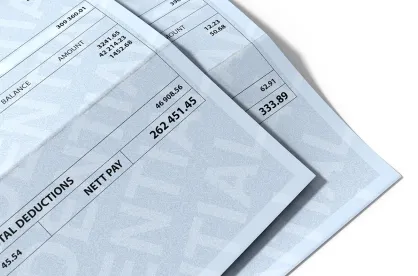The long-awaited regulations from the Illinois Department of Labor (IDOL) governing the amendments to the Illinois Equal Pay Act (IEPA) were published, further clarifying the practical implications of obtaining an equal pay registration certificate under the IEPA.
Background
The 2021 amendments to Section 11 of the IEPA require businesses with at least 100 individuals employed in the State of Illinois to obtain an equal pay registration certificate certifying compliance with the Act from the IDOL.
The amendments set forth various requirements for applying for the certificate, including:
(1) A $150 filing fee;
(2) A “wage records” list of all employees who worked for the business in the past calendar year, categorized by gender and race/ethnicity, including a copy of the business’ most recently filed EEO-1 report; and
(3) A statement signed by an officer of the business making several affirmations of compliance.
After a lengthy public comment period to the IDOL’s May 20, 2022, proposed regulations, the final regulations were published on January 6, 2023. Unfortunately, while the regulations offer some clarity on the IDOL’s expectations, many ambiguities remain for businesses subject to the IEPA. Some key highlights from the regulations are summarized below.
Clarification on Enrollment Requirements
The regulations clarify that all business that were authorized to transact business in Illinois on or before March 23, 2021, must submit an online enrollment form notifying the IDOL that the business is subject to the equal pay registration certificate requirement and provide contact information for the business. A business that becomes authorized to transact business in Illinois on or after March 24, 2021, is required thereafter to submit an enrollment form to the IDOL by January 1 of the calendar year following the year the business became authorized to transact business in Illinois.
Definition of “Employee”
Understanding who meets the definition of an Illinois employee is important in determining whether a company meets the 100-Illinois-employee threshold requiring it to certify. The regulations borrow from the Illinois Income Tax Act and define “employee” as any person performing a service for a business:
whose base of operations, or if there is no base of operations, the place from which the service is directed or controlled, is located within the State of Illinois; or whose base of operations or the place from which the service is directed or controlled is not in any state in which some part of the service is performed, but the individual’s residence is in the State of Illinois.
With many employees still working remotely, employers will have to closely examine work assignments to determine whether an employee should be counted and included in the determination of whether they employ the requisite number of employees in the State of Illinois.
Requirements for “Wage Records”
The regulations require that the “wage records” included in the application consist of a list of all employees during the payroll year (January 1 through December 31) immediately preceding the application due date, separated by gender, race, and ethnicity categories in a text-searchable, sortable Microsoft Excel file or comma-separated values file format, as well as any other information required by the IDOL on the application form.
For purposes of this report, wages “shall be reported by either the mean hourly wage (for employees paid hourly wages) or annual mean wage (for salaried employees).” This departs from the language of the IEPA, which requires the “wage records” list also include information regarding the county in which each employee works, the date each employee started working for the business, and the “total wages as defined by Section 2 of the Illinois Wage Payment and Collection Act paid to each employee during the past calendar year, rounded to the nearest $100” (i.e., not the mean hourly or annual mean wage for each employee).
Definition of “Average Compensation”
As part of the compliance statement, businesses must certify that the average compensation for its female and minority employees is not consistently below the average compensation for its male and non-minority employees within each of the major EEO-1 categories.
The regulations define “average compensation” as the average wages for a specific occupation in the State of Illinois as determined by the most recent U.S. Bureau of Labor Statistics State Occupational Employment and Wage Estimates publication.
Definition of “Compliance”
As part of the process to obtain an equal pay registration certificate from the IDOL, a business must submit a statement signed by an officer of the business certifying compliance with several equal pay statutes.
The regulations define “compliance” to mean, as of the date of application or recertification, the business:
(1) Has not had any final non-appealable adverse judgment or administrative ruling entered against it in the previous two years under Title VII of the Civil Rights Act of 1964, the Illinois Human Rights Act, the Equal Wage Act, or the Equal Pay Act of 2003; or
(2) Has corrected any final and non-appealable adverse judgment or administrative ruling entered against it under Title VII of the Civil Rights Acts of 1964, the Illinois Human Rights Act, the Equal Wage Act, or the Equal Pay Act of 2003.
If a business has had a qualifying civil judgment or administrative finding and has since corrected such adverse finding, the business must submit a copy of the adverse civil judgment or administrative finding with the corrective measures that were undertaken by the employer.
Timing of IDOL Decision
The regulations establish that within 45 calendar days after receipt of an application, the IDOL will issue to the business its equal pay registration certificate or a Statement of Rejection notifying the business of the reasons the application was rejected.
The regulations also reconfirm that a business will have 30 calendar days from the date it receives the Statement of Rejection to cure application deficiencies. They also outline an appeals process that may be initiated by a business within 14 calendar days of receiving a Statement of Rejection.
Assignment of Filing Dates
The IDOL will assign every business a date by which it must submit its application for the certificate. Each business will receive at least 120 calendar days’ notice of the filing date. Thereafter, the business must obtain a new certificate every two years after the initial due date, unless the business has fewer than 100 employees on December 31 of the year immediately preceding the filing year.
Duty to Revise Erroneous, Incomplete Application
The regulations require businesses to submit revised applications if it is later discovered that incorrect or incomplete information was submitted in an application.
The revised application should include the correct or complete information, along with a letter identifying the information that was amended.
A business that makes a correction will not be subject to penalties if the incorrect or incomplete information was provided in good faith and without knowledge that such information was incorrect or incomplete.
Employee Requests for Data
The regulations detail the process by which current employees of a business may request anonymized data regarding that employee’s own job classification or title and the pay for that title or classification.
A request for data must be submitted in writing to the IDOL. It must include the employee’s name, date of hire, job title or classification, the dates for which the data is being requested, a signed affidavit swearing that the employee holds the specified job title at that business, and evidence that the employee currently holds the specified job title at that business. Upon request, and if in the possession of the IDOL, the IDOL will provide current and historical data from no more than 10 years prior to the date of the request to a requesting employee, based on the data timeframe specified in the request for employees working in the same county as the requestor.
Looking Ahead
Although the regulations provide clarity on some aspects of the equal pay registration certificate and application process, several ambiguities remain that will likely need further statutory clarification or additional guidance from the IDOL. Some of these ambiguities include how and where businesses should enroll with the IDOL, the appropriate definition of “wages” for purposes of the wage records submission, and what data must be provided to IDOL as part of the application.
Further clarity also will be required on how the IDOL expects businesses to calculate the “average compensation” for the compliance statement, given the new definition contained in the regulations confusingly references U.S. Bureau of Labor Statistics State Occupational Employment and Wage Estimates publication data, which is reported by Standard Occupational Classification rather than by the separately established EEO-1 job categories or by gender, race, or ethnicity demographics.
The IDOL is expected to revise its FAQs to incorporate and address the adopted regulations and, perhaps, resolve the outstanding questions and concerns.





 />i
/>i

